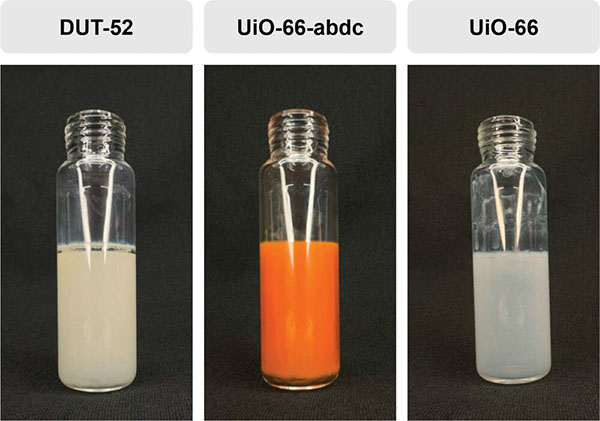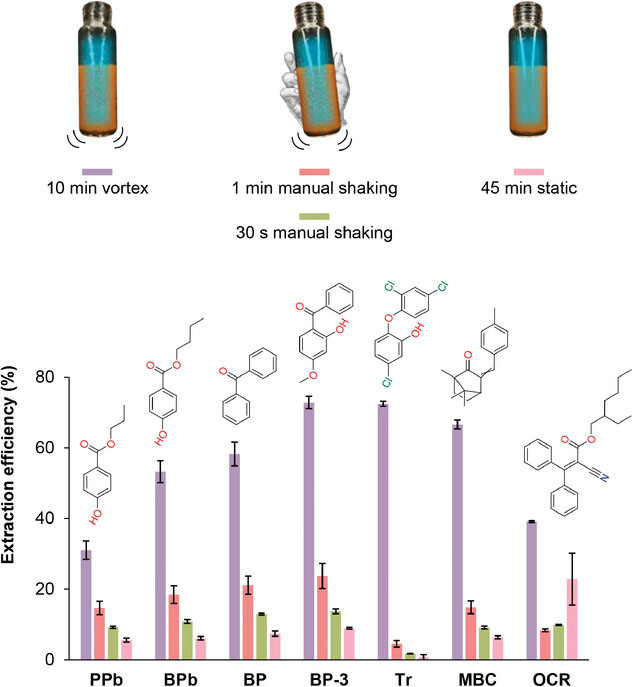| Apr 18, 2024 | |
Metal-organic framework coatings enable simple, reusable water contaminant testing |
|
| (Nanowerk Spotlight) Ensuring the safety of our water supplies requires the ability to detect even trace amounts of pollutants. However, traditional testing methods often involve complex and time-consuming sample preparation steps that hinder timely and efficient monitoring. In pursuit of simpler and more effective solutions, scientists have turned to advanced materials known as metal-organic frameworks (MOFs). | |
| MOFs are highly porous crystalline compounds made up of metal ions linked by organic molecules. By varying the building blocks, MOFs can be engineered with tailored pore sizes and chemical properties to selectively capture specific substances. While their unique attributes have shown promise in diverse applications from gas storage to drug delivery, challenges in integrating MOFs into practical devices have limited their real-world adoption. | |
| Now, a team of researchers from the Universidad de La Laguna in Spain has developed a groundbreaking yet elegantly simple approach that could revolutionize water testing by harnessing the power of MOFs. As reported in Advanced Functional Materials ("Metal–Organic Framework-Coated Glass Vials: A Step Forward in Analytical Platforms"), the scientists have devised a method to grow uniform MOF coatings directly onto the inner walls of ordinary glass sample vials. This innovation transforms the vial itself into a highly efficient tool for extracting target contaminants from water. | |
 |
|
| MOF-coated vials. (Image: Reprinted from doi:10.1002/adfm.202402517, CC BY) | |
| To create the MOF-coated vials, the researchers first modified the glass surface with special chemical groups that serve as anchor points for the MOF crystals to grow on. They then tested their technique with three zirconium-based MOFs known as UiO-66, DUT-52 and UiO-66-abdc, chosen for their stability and tunable pore structures. Detailed imaging revealed dense, even layers of MOF nanoscale crystals lining the vial walls. | |
| The real proof of performance came from experiments evaluating the MOF-coated vials' ability to extract trace contaminants from water. The researchers focused on a class of chemicals including endocrine disruptors and substances from personal care products, which are concerning even at very low levels. Incredibly, the vial coated with UiO-66-abdc captured 90% of the contaminants from a water sample in just one hour. | |
| What's more, the contaminants could then be released from the MOF in mere minutes using a simple solvent wash, allowing the preconcentrated substances to be easily analyzed. This is a major advancement over current techniques like solid-phase microextraction (SPME), which uses polymer-coated fibers to extract contaminants. SPME fibers are fragile, can't be used with many common solvents, and are limited in their ability to capture a wide range of pollutants. | |
| In contrast, the MOF-coated vials were incredibly durable, remaining stable and effective for over 50 re-uses - a testament to the robustness of the MOF materials. Combined with high-performance liquid chromatography (HPLC), an analytical technique that separates compounds based on their interactions with a solid material and a liquid solvent, the MOF vials achieved remarkable sensitivity, detecting contaminant levels as low as 0.1 micrograms per liter in swimming pool water. | |
 |
|
| Expanding the simplicity of the microextraction modes using the MOF-coated vial. The experiments were carried out in triplicate and carried out with the same experimental conditions (18 mL of aqueous standard at 20 μg L−1). (Image: Reprinted from doi:10.1002/adfm.202402517, CC BY) | |
| The potential applications of this novel platform are vast. As study co-lead Dr. Verónica Pino explains, "The vial acts simultaneously as the sample container and extraction device, greatly simplifying the analytical workflow." The MOF coatings eliminate the need for cumbersome sample preparation, as the vial can simply be filled with a water sample, shaken, and then emptied before analyzing the captured contaminants. | |
| This streamlined approach opens up exciting possibilities for field testing and continuous monitoring. The ability to use a single vial for multiple tests with minimal processing in between could dramatically improve the speed and efficiency of water quality analysis. Furthermore, the MOF's tunability means the vials could be tailored to detect specific pollutants of concern in different contexts, from municipal water treatment to agricultural runoff monitoring. | |
| Looking ahead, the research team plans to develop MOF coatings optimized for additional contaminant types and to explore integrating the vials with portable testing systems for on-site analysis. With further refinement and scale-up, MOF-coated vials could become a go-to tool for safeguarding our water resources. | |
| While the scientific community has long recognized MOFs as materials with extraordinary potential, this study marks a major leap in translating their unique properties into a practical, impactful application. By wedding MOFs' selectivity and stability with the humble glass vial, these researchers have opened a new frontier in water monitoring, one that promises simpler, faster and more effective ways to keep our water supply safe. | |
 By
Michael
Berger
– Michael is author of three books by the Royal Society of Chemistry:
Nano-Society: Pushing the Boundaries of Technology,
Nanotechnology: The Future is Tiny, and
Nanoengineering: The Skills and Tools Making Technology Invisible
Copyright ©
Nanowerk LLC
By
Michael
Berger
– Michael is author of three books by the Royal Society of Chemistry:
Nano-Society: Pushing the Boundaries of Technology,
Nanotechnology: The Future is Tiny, and
Nanoengineering: The Skills and Tools Making Technology Invisible
Copyright ©
Nanowerk LLC
|
|
|
Become a Spotlight guest author! Join our large and growing group of guest contributors. Have you just published a scientific paper or have other exciting developments to share with the nanotechnology community? Here is how to publish on nanowerk.com. |
|
